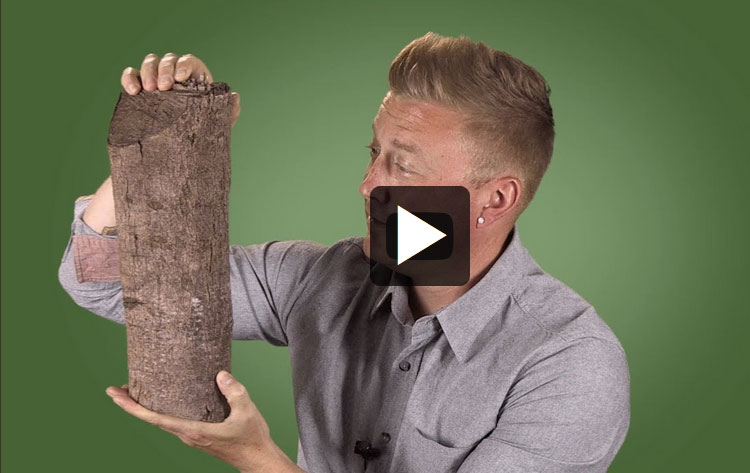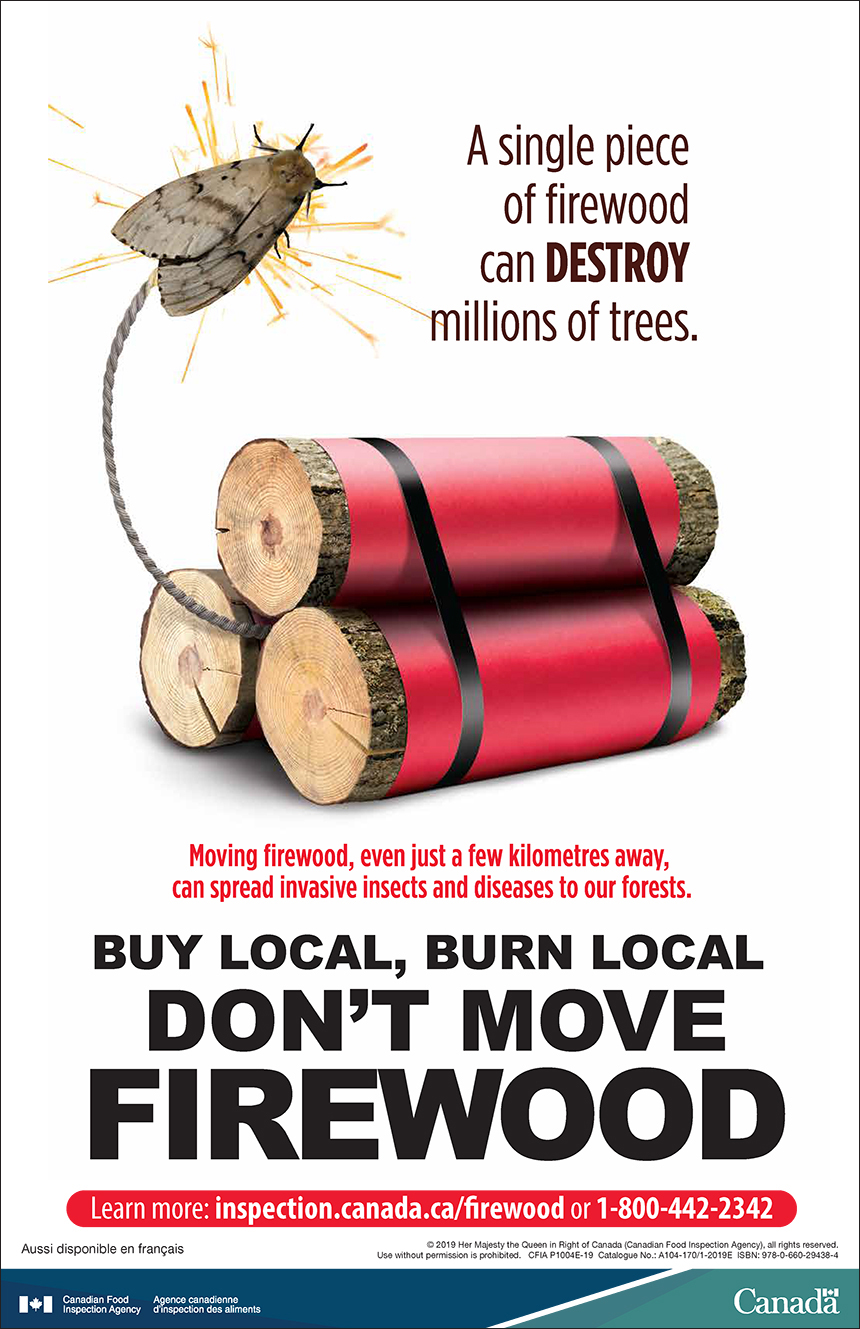Hazards of moving firewood
On this page
- Don't move firewood – buy local, burn local
- Pests to watch out for
- Considerations for camping
- Regulated areas
- Movement restrictions
- Importing firewood
- Printable resources
Don't move firewood – buy local, burn local
Although we might not see them, invasive insects that threaten our forests can easily hide in firewood. When firewood moves, so do these pests, potentially threatening our beautiful forests.
The movement of firewood poses a substantial risk to Canada's economy and environment.
Transporting firewood may seem harmless but can lead to the spread of pests such as insects, plants and diseases. An infestation of invasive species can limit your ability to enjoy the environment around you and negatively affect the property value of your home.
Firewood and its bark can be infested with insect eggs or larvae. If you move firewood, for example from your home to your cottage or campsite, you could unintentionally spread a pest like emerald ash borer to a previously pest-free area. Help protect our forests by following these firewood guidelines:
- Buy and burn your firewood locally. Transporting wood long distances can lead to a free ride for invasive species of all sorts across Canada.
- Know where the wood is coming from. If you buy wood from a local supplier, don't be afraid to ask where it came from. Buy wood that was cut less than 80 kilometres away from where it is being sold.
- Don't "judge a book by its cover". Just because you can't see signs of pest infestation doesn't mean the pests aren't there. It can be extremely difficult to notice insects, insect eggs and fungal spores on wood.
- Spread the word, not the bug. Tell your family, friends and colleagues. If you are having people over for a fire in your backyard or at your campsite or going on a camping trip, make sure those who are joining you are aware of this threat.
Be aware of movement restrictions
Moving firewood from places where regulated pests have been found can be a violation of the Plant Protection Act, with penalties of up to $50,000 and/or prosecution. Be aware of movement restrictions that may be in place before you move wood or wood products.
For more information about these restrictions, contact your local Canadian Food Inspection Agency (CFIA) office.
Pests to watch out for
You can do your part by staying informed of how pests spread, reporting suspected sightings, spreading the word and keeping firewood local.
The Canadian Food Inspection Agency (CFIA) is dedicated to preventing the spread of plant pests. The CFIA has import requirements in place, regulates the movement of plant species in Canada, monitors invasive species that are not yet established in Canada, and determines if invasive species are established.
Learn more about invasive species and how to identify them.
Emerald ash borer
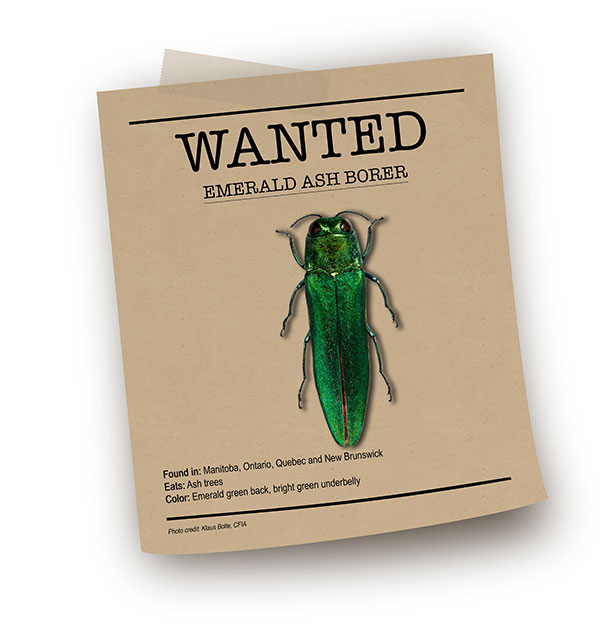
- Found in: Manitoba, Ontario, Quebec, New Brunswick and Nova Scotia.
- Eats: Ash trees
- Colour: Emerald green back, bright green underbelly
If you live in Manitoba, Ontario, southern Quebec, New Brunswick or Nova Scotia, you may have already heard of this guy. The emerald ash borer is a highly destructive invasive beetle that attacks and kills all species of ash trees. It was first found in Canada in the summer of 2002. In the short time it has been in North America, it has killed millions of trees in the U.S. and Canada, and is a very serious threat to all species of ash trees throughout their range. For example, in the National Capital Region (Ottawa-Gatineau) there are no un-infested ash trees left!
Asian longhorned beetle
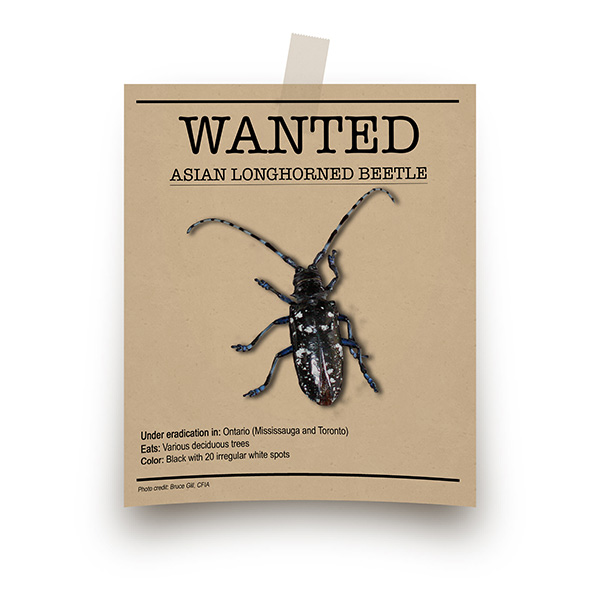
- Eradicated in: Ontario (Mississauga and Toronto)
- Eats: Various deciduous trees
- Colour: Black with 20 irregular white spots
Native to Asia, the Asian longhorned beetle would like to fool us into thinking it is Canadian due to its love of maple, but don't fall for its tricks! It is an invasive species that is a major threat to maple trees in the greater Toronto area. Could you imagine a world without sugar bushes or maple syrup, and a Canadian flag without a maple leaf? We sure don't want to, so let's not let Asian longhorned beetles spread!
Brown spruce longhorn beetle
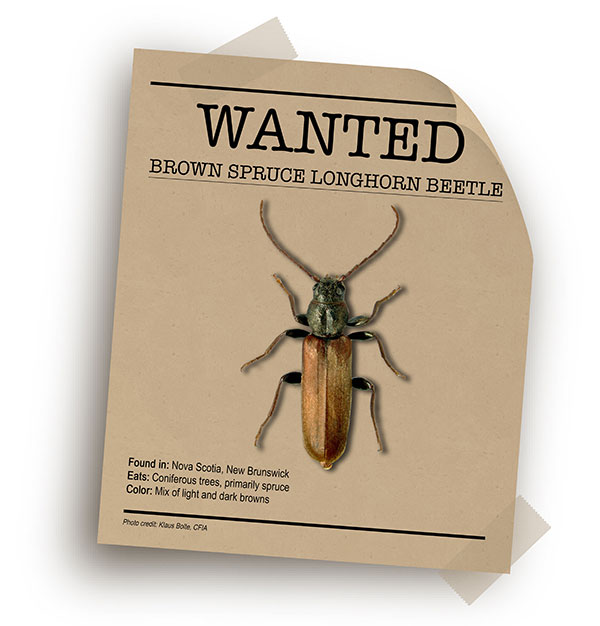
- Found in: Nova Scotia, New Brunswick
- Eats: Coniferous trees, primarily spruce
- Colour: Mix of light and dark browns
Coming from northern and central Europe, as well as western Siberia, the brown spruce longhorn beetle (BSLB) has been found in Nova Scotia and New Brunswick, and targets trees in the spruce family. Its larvae feed on the inner bark of spruce trees, primarily concentrated in the lower portion of the tree. If a tree is heavily infested by BSLB over a number of years, it will eventually die. Although it was initially thought to be a very serious threat, research has shown that it spreads relatively slowly by natural means, but it could spread unexpectedly if infested firewood is moved.
Spongy moth
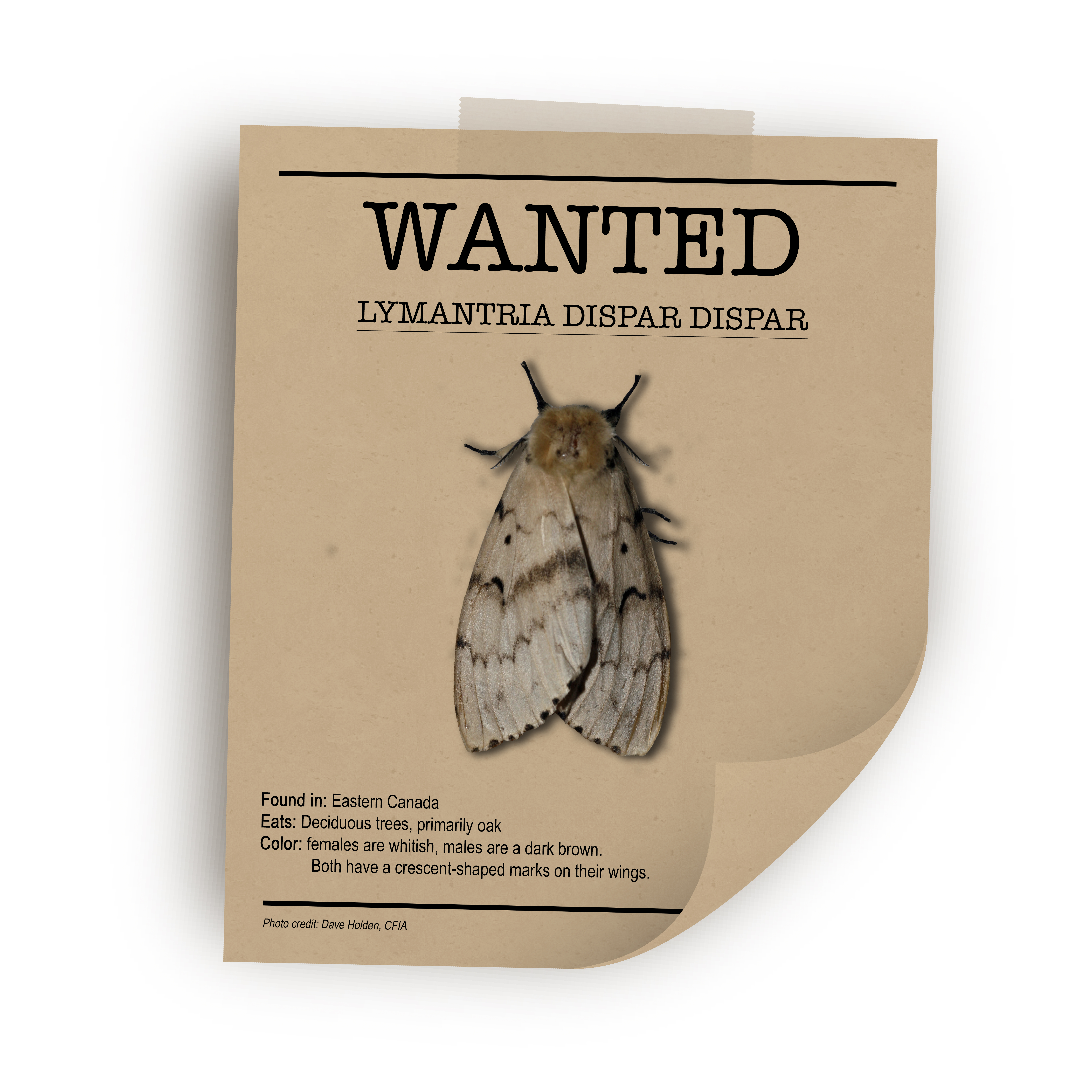
- Found in: eastern Canada
- Eats: Deciduous trees, primarily oak
- Colour: Females are whitish, males are a dark brown. Both have crescent-shaped marks on their wings
The spongy moth is a hungry little bug from Europe that can now be found in eastern Canada. Female moths lay egg masses on tree bark, branches and other places, like piles of firewood. The larvae will eat leaves from their host tree as they grow, starting with small holes and eventually consuming the entire leaf when they reach maturity. A high population of moths and larvae can strip all leaves from a tree, killing it. Help stop their spread by making sure not to move firewood.
Changes to common names
The common names for some insects are under review internationally. Spongy moth is the new common name for Lymantria dispar dispar, previously known as European gypsy moth, EGM or LDD moth. This change does not affect the French name.
The common name for the group of moths (Lymantria dispar asiatica, Lymantria dispar japonica, Lymantria umbrosa, Lymantria postalba and Lymantria albescens) referred to as AGM (formerly Asian gypsy moth) has changed to Flighted Spongy Moth Complex (FSMC).
Considerations for camping
Going to a national park? Help protect it
National parks are among Canada's, and the world's, natural gems. They are a source of pride for Canadians and an integral part of our identity, which is why it is so important to keep these ecosystems healthy and whole.
To protect the park, only use local firewood and contact Parks Canada for any additional restrictions when you are planning your trip.
Regulated areas
The CFIA establishes regulated areas to restrict the movement of potentially infested wood items from one area to another. To protect our forest resources, moving firewood outside of a regulated area is prohibited. It is important to be familiar with the pests present in your area or the area you are planning to visit to know what to look for. Visit the pest links listed below (by province) to learn more about their regulated areas.
British Columbia
Alberta
- Currently free from federally regulated pests. Provincial legislation prohibits the movement of elm wood.
Saskatchewan
Manitoba
New Brunswick
Nova Scotia
Newfoundland and Labrador
- Currently free from regulated pests associated with firewood
Prince Edward Island
Movement restrictions
Moving freshly logged trees can also spread pests. Logging and other industries work closely with the Canadian Food Inspection Agency to use safe movement practices and certification programs.
Moving firewood from places where regulated pests have been found is a violation of the Plant Protection Act, with penalties of up to $50,000 and/or prosecution. Be aware of movement restrictions that may be in place before you move wood or wood products.
For more information about these restrictions, contact your local CFIA office.
When moving wood is allowed
- Moving firewood within a regulated area.
- Moving firewood within non-regulated areas, provided you do not pass through a regulated area.
- Moving firewood outside of regulated areas with a movement certificate obtained from the CFIA for heat treated firewood, or, under compliance agreement.
Importing firewood
You cannot import firewood from any country, strict requirements must be met.
Firewood that does not meet Canada's import requirements will be refused entry, returned to its place of origin or disposed of at the importer's expense. You could also face penalties or prosecution if you do not declare restricted or prohibited items such as firewood. When returning to Canada, declare all foods, animals, plants and related products at customs.
Printable resources
- Date modified:
